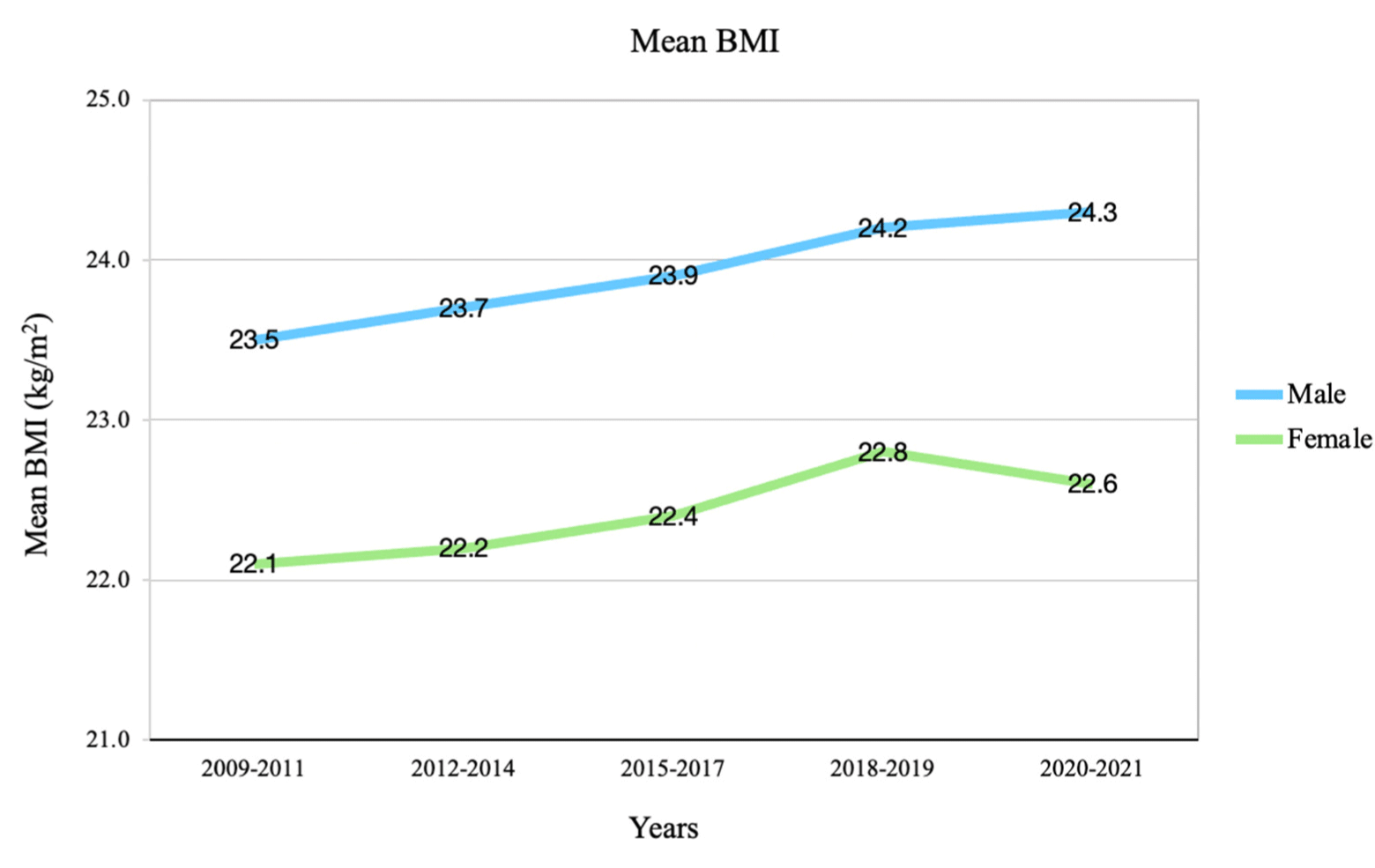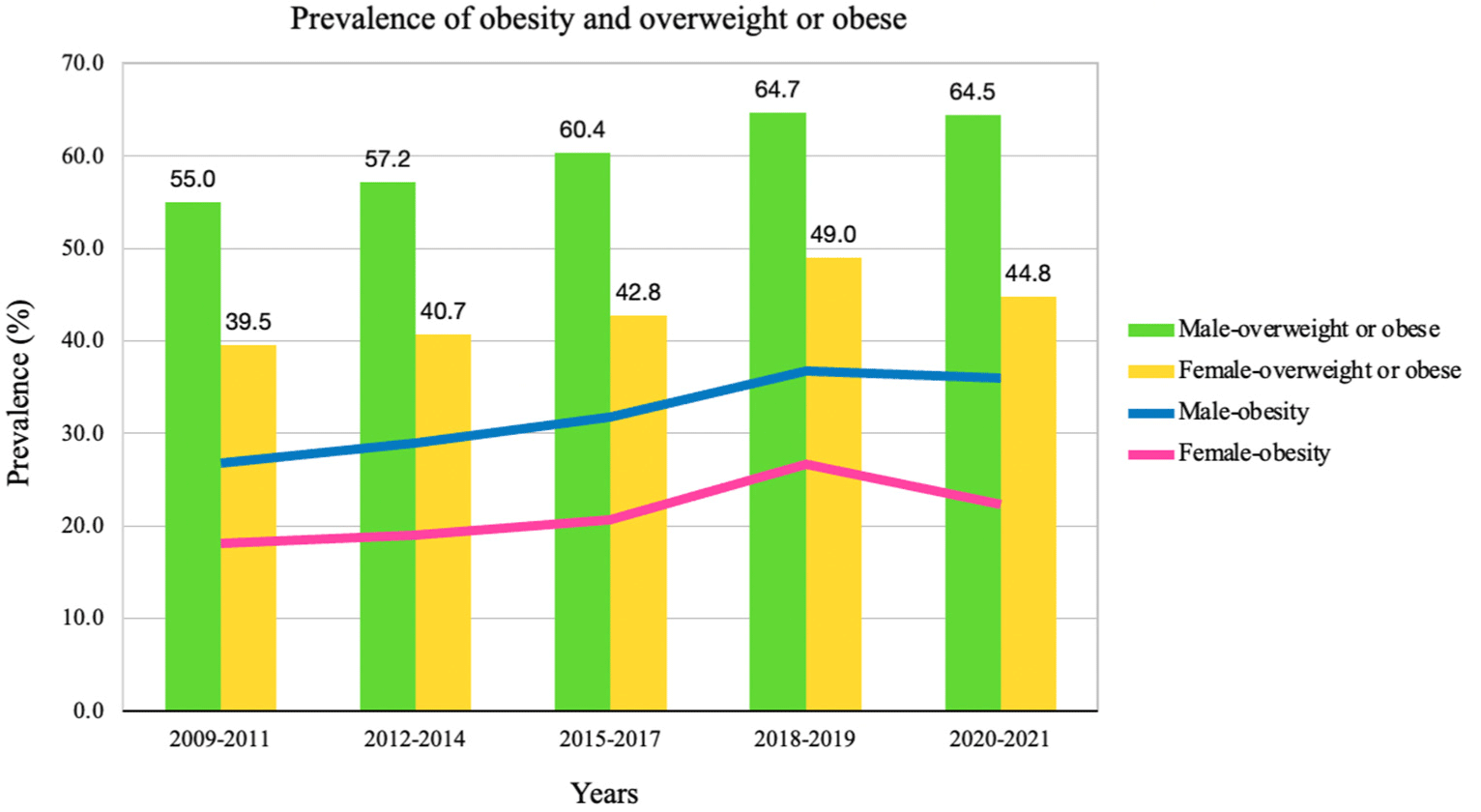1. Introduction
Health experts are concerned about the association between obesity and a number of diseases, such as diabetes, heart disease, and cancer.[1] In the interim, several restrictions, including social withdrawal, a contactless culture, and limitations on physical activity, have been imposed on people globally since the emergence of COVID-19 pandemic in an attempt to stop the spread of the severe acute respiratory syndrome coronavirus 2 (SARS-CoV-2).[2] Furthermore, the World Health Organization (WHO) raising awareness regarding the dangers of obesity; however, a rise in body mass index (BMI) seems inevitable given the decline in physical activity and change in eating habits.[3, 4]
2. Previous study
We have previously published research; however, due to preliminary results, we will now provide a more detailed description of the methodology employed.[5, 6] The Korea Community Health Survey (KCHS) is, substantially, a continuous series study designed to monitor health-related behaviors in Koreans. The present study collected data on health behaviors, body measurements, and health-related outcomes from Korean citizens (aged ≥ 19 years).[6] A sampled house was visited by trained respondents who conducted a 1:1 interview survey. The systematic selection of households and preparation of the sampling frame were executed using data from the Ministry of Land, Infrastructure, and Transport’s housing statistics and the Ministry of the Interior and Safety’s resident registration population.[6] The KCHS data were anonymous.
The biological variables were sex, age (19–39, 40–59, and ≥60 years old), subjective health status (bad, normal, and good), and smoking behavior (yes and no). Urban residence (yes and no), income (unknown, <3, 3–5, and ≥5 million won per month), final educational background (elementary school or less, middle school, high school, and college or more), marital status (yes and no), and basic beneficiary status (yes and no) were all included for participants. We used results of the KCHS from 2009 to 2021, stratified by the aforementioned factors.[7, 8] We verified sex-specific trends in mean BMI and frequency of overweight and obesity before and after the COVID-19 pandemic.
Fig. 1 shows the weighted mean with 95% CI and BMI trends for each biosocial component for 13 years for males and females. An increase in the rate of BMI change was apparent in both sexes among unemployed individuals (βdiff, 0.179; 95% CI, -0.028–0.490 for male; βdiff, 0.285; 95% CI, -0.043–0.689 for female). In addition, we observed that individuals who were youthful, healthy, smokers, residents of rural areas, unemployed, and recipients of basic benefits were more susceptible to weight increase when comparing the rate of change in BMI before and after COVID-19.
Fig. 2 presents the prevalence of obesity for each period and BMI trend among men and women with a BMI above the overweight threshold. Obese and overweight and obese individuals were more common among males. The BMI trend decreased less in the obese, obese and overweight, and overall groups.

3. Comparison of previous studies
The preponderance of earlier studies (Korean adults, n=6569[9] or 39,060[10]) has described the trend in BMI and prevalence of obesity among Koreans prior to the pandemic Some studies have observed associations between BMI and obesity and variables based on socioeconomic status and sex (Korea, n=17,312[11]), as well as wealth and education (Korean adults, n=39,060[10]). Although there are several studies on BMI changes during the pandemic[12, 13], the group sizes in these studies were too small to be representative, and the studies only examined short-term trends. In addition, these studies discovered a few stratified trends in BMI. Few studies have compared the before and after COVID-19 period among adults by looking at the entire COVID-19 period. Thus, we conducted a statistical study using weighted data collected from 2, 581, 673 adults from over a 19-year period. In addition, we investigated the prevalence of overweight and obesity and relationships between the nine risk variables and BMI based on a biosocial model.
4. Plausible mechanism
Our findings revealed that total BMI remained elevated from 2009 to 2019. Several previous papers have also observed this trend.[14] However, there was a decrease in trend differences in all groups classified by age, health, smoking status, urban residence, income, final educational background, marital status, and basic beneficiary status, indicating that BMI increased less than predicted prior to the COVID-19 pandemic. In terms of sociocultural factors, changes in workplace[15], culture, and interpersonal stress[16] caused by COVID-19 could have resulted in a decrease in BMI. Furthermore, social isolation caused by COVID-19 may have worsened,[16] and the ensuing stress may have had a negative impact on BMI[17].
In terms of personal life habits, the reasons could be that outdoor dining and appointments decreased, the frequency of consuming calorie intake decreased[18], and interest in health increased significantly, resulting in the spread of ‘home training’.[19-21] However, BMI may rise during the COVID-19 era due to increased food delivery,[19, 20] stress from non-face-to-face culture,[22] and reduced outdoor exercises.[23] The statistical analysis of BMI trends suggests that the decreasing component exceeded the increasing factor.
Furthermore, women experienced a greater decrease in BMI. This is anticipated because women are more active in health management activities[24] such as home training and diet management. Younger age, higher income and education, and no marital status individual groups were identified as vulnerable categories. This may be because COVID-19 has varying positive and negative effects based on the lifestyle of each group.
5. Policy implications
Obesity has been linked to severe diet-related noncommunicable diseases like diabetes mellitus, cardiovascular disease, hypertension, stroke, and some cancer types, which explains why the WHO has repeatedly warned against it.[25] However, eating patterns, fitness routines, and social interactions have significantly changed as a result of COVID-19.[26] Lockdowns, social estrangement, and increase indoor time all contributed to a decrease in physical exercise and an increase in food delivery, which may contribute to obesity.[27] As a result, medical experts should update their current obesity guidelines. In addition, they should encourage healthy diet and appropriate physical activities. The risks of fat intake, including lifestyle diseases, dyslipidemia, and cardiovascular disease, must be better understood. We recommended the initiation of a national campaign to encourage a healthy diet and regular exercise. It would be beneficial to encourage people to be physically active, similar to the “Be Active” program during the COVID-19 pandemic.[28] Furthermore, this study discovered that those who were younger, had higher income and education, and of no marital status were more vulnerable than others. Therefore, lawmakers should focus on reducing disparities exacerbated by the pandemic.
6. Limitations and strengths of previous published study
This study has some limitations. First, because the BMI statistics were self-reported, there may have been response bias. Given that excessive BMI was considered a socially undesirable mindset, participants may have concealed their BMI. By re-extracting 13% of the respondents from the survey through a third institution and performing phone inspections, we hoped to ensure the validity of the data. Finally, because only Korean adults were included in the data used for this study, we could not demonstrate the global trend in BMI, but demonstrated only the national trend. However, this study is the first to examine the long-term trend in BMI among Korean adults and how COVID-19 has changed the trend. Furthermore, we included 2.5 million participants from 13 years of nationwide data, whereas earlier studies have smaller sample sizes. This study provided data indicative of the adult population in South Korea because weights were taken into consideration. The findings of this study may support decisions made regarding Korean health policies.
7. Conclusion
Overall, this review study examined Korean adults’ long-term trends in BMI. Compared to what was anticipated prior to the pandemic, BMI increased noticeably across all sociodemographic categories. However, the pandemic caused a decline in BMI across all categories. The vulnerable categories were individuals who were younger, had higher income and education, and of no marital status. Even during the pandemic, the prevalence of overweight and obesity should be constantly monitored to understand their correlations with various risk factors. To prevent the BMI trend from continuing after COVID-19, policymakers may be inspired by this study to review obesity guidelines and promote healthier diets and increased physical activity.








